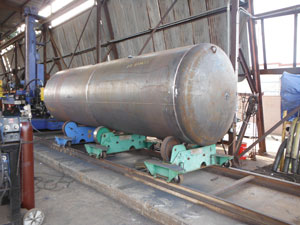Partnering for Success: Selecting the Right Tank Welding Inspection Company
Partnering for Success: Selecting the Right Tank Welding Inspection Company
Blog Article
Comprehensive Storage Tank Welding Assessment for Industrial Safety and Regulatory Conformity
Ensuring industrial security and regulatory compliance within the realm of storage tank welding assessments is a vital facet of preserving operational stability and mitigating potential risks. The precise assessment of weld top quality, material thickness, and total tank condition is critical in safeguarding against ecological hazards and architectural failures. By diving into the details of comprehensive storage tank welding inspections, a deeper understanding arises of the multifaceted strategies employed to support sector requirements and support security methods.
Significance of Tank Welding Examinations
Carrying out comprehensive and periodic storage tank welding inspections is crucial in making sure the architectural stability, safety standards, and regulative compliance of industrial tanks. These evaluations play a crucial role in determining any kind of possible issues or weak points in the welded joints that can endanger the overall stability of the storage tank. By finding these concerns early, companies can take aggressive procedures to address them quickly, therefore avoiding pricey repair services, ecological contamination, or, in the worst-case circumstance, catastrophic failings.
Routine storage tank welding assessments additionally assist companies abide with market regulations and standards stated by authorities such as the American Petroleum Institute (API) or Occupational Safety And Security and Health And Wellness Management (OSHA) Failure to fulfill these requirements can lead to fines, lawful repercussions, or perhaps the suspension of procedures. Tank Welding Inspection Service. As a result, investing in comprehensive storage tank welding assessments not just safeguards the health of personnel and the surrounding atmosphere yet additionally safeguards the business's reputation and lower line in the future
Key Components of Weld High Quality Analysis
Making certain the top quality of welds involves a meticulous analysis of essential elements that add to the structural stability and reliability of commercial storage tanks. One important aspect of weld top quality analysis is the examination of weld penetration. Appropriate infiltration is vital as inadequate infiltration can result in weld issues and compromise the strength of the joint. Additionally, the weld's profile need to be assessed to guarantee that it fulfills the given requirements in terms of shapes and size. The existence of any suspensions, such as fractures, porosity, or incomplete fusion, must be completely checked as these can damage the weld and enhance the chance of failing. Furthermore, the total weld appearance is additionally a vital part of quality evaluation, as it can indicate the presence of problems or disparities in the welding procedure. By comprehensively reviewing these vital components, assessors can assist ensure that welded joints satisfy the essential requirements for security and governing conformity in industrial container construction.
Material Density Analysis Methods
In the context of weld quality evaluation, an important facet to think about is the use of product density examination techniques. Exact measurement of material thickness is vital in ensuring the architectural honesty and safety of welded containers. Various non-destructive screening (NDT) techniques are used for analyzing material thickness, including ultrasonic screening, radiographic testing, and magnetic fragment examination. Ultrasonic screening entails the use of high-frequency sound waves to determine material density by measuring the time taken for the audio waves to travel through the material and show back. Radiographic screening utilizes X-rays or gamma rays to create pictures showing worldly density. Magnetic fragment inspection is efficient for identifying surface area and near-surface issues that might impact product density. These techniques not only aid in assessing the density of products yet likewise aid in recognizing any prospective defects or interruptions that could compromise the weld top quality and general integrity of the storage tank framework. By using these product thickness evaluation strategies, industries can make certain conformity with safety and security criteria and laws, consequently boosting general operational safety and security and dependability.
Container Condition Exam Techniques
An important element in keeping the stability and security of welded storage tanks is the complete examination of container conditions with reliable inspection techniques. Container problem examination approaches play a crucial duty in making sure the architectural soundness and functional effectiveness of industrial storage tanks. Normal examinations using these techniques are necessary for protecting This Site against devastating failings and making sure the long-term dependability of welded containers.
Benefits of Normal Evaluation Practices
Normal evaluation practices not only protect against prospective issues detected throughout click site tank condition assessment techniques but also work as proactive actions in upholding the architectural honesty and operational performance of bonded storage tanks. By conducting routine evaluations, commercial facilities can determine any indicators of corrosion, cracks, leakages, or other flaws in the container welds without delay. This very early detection allows prompt fixings or upkeep treatments, preventing small concerns from intensifying right into bigger, extra pricey issues that can endanger security or cause regulative non-compliance.

Conclusion

Finally, thorough container welding evaluations are important for guaranteeing industrial safety and regulatory compliance. By conducting regular inspections and assessments of weld top quality, product density, and tank problem, organizations can identify potential risks and prevent pricey accidents. Implementing an aggressive technique to evaluation practices can help preserve the architectural integrity of containers, safeguard the setting, and make certain the safety and security of you could try here workers and the surrounding neighborhood.

Report this page